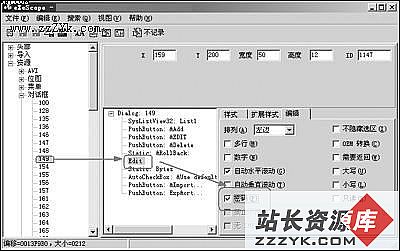答案:Request Object:
Request has five (5) Collections, one (1) Property, and one (1) Method. You'll use the Collections far more than the property or the method.
Request Collections:
Below is a table of the Request Collections and descriptions of how they are used.
| ClientCertificate | Request.ClientCertificate("Key[Field]") Client security info for SSL encryption |
| Cookies | Request.Cookies("cookieName") Holds cookie value stored on the client |
| Form | Request.Form("formName") Holds value sent via HTML Form |
| QueryString | Request.QueryString("keyName") Name/Value pair appended to the end of the URL |
| ServerVariables | Request.ServerVariables("variableName") Hold values sent in the HTTP Headers |
ClientCertificate:
Request.ClientCertificate is used with S.S.L. (Secure Sockets Layer). It is beyond the scope of this web site.
Cookies:
We will learn Request.Cookies and Response.Cookies together in Lesson 08. Please be patient.
Form:
Request.Form is probably the workhorse of the Request Collections. The first script is a repeat from Lesson 03.
<%@LANGUAGE="JavaScript"%> <% //No ASP Here, just a regular HTML Page %> <HTML> <STRONG>Type something into the text box and submit it.</STRONG> <FORM ACTION="script08a.asp" METHOD="Post"> <INPUT TYPE="Text" NAME="WebPageVariable"><BR> <STRONG>How Much Money do you make each month?</STRONG><BR> <SELECT NAME="monthlySalary"> <OPTION>Under $5,000,000</OPTION> <OPTION>Above $5,000,000</OPTION> <OPTION>Nobody's darn business.</OPTION> </SELECT><BR> <INPUT TYPE="Submit" VALUE="Submit"> </FORM> </HTML>
Click Here to run script08.asp in a new window. It posts information to script08a.asp which is found below. In turn, script08a.asp posts information to script08b.asp which is also found below.
<%@LANGUAGE="JavaScript"%>
<%
var WebPageVariable = new String( Request.Form("WebPageVariable") )
WebPageVariable = WebPageVariable.toUpperCase();
var monthlySalary = new String( Request.Form("monthlySalary") )
monthlySalary = monthlySalary.toLowerCase();
%>
<HTML>
The Web Page Variable you typed is: <%=WebPageVariable%> <BR>
The monthly salary you listed is: <%=monthlySalary%> <BR>
<FORM ACTION="script08b.asp" METHOD="Get">
<INPUT TYPE="hidden" VALUE="<%=monthlySalary%>" NAME="QueryVariable">
<STRONG>Click the button to see Query Strings</STRONG><BR>
<INPUT TYPE="submit" VALUE="Submit">
</FORM>
</HTML>
We'll be using Request.Form when we "Post" an HTML form to the server. Notice that the NAME attribute in the HTML form corresponds to the "name" in
QueryString:
We'll be using Request.QueryString when we use an HTML form to "Get" a page from the server. Request.QueryString() is very similar to Request.Form(). Take a look at script08b.asp which I printed below.
<%@LANGUAGE="JavaScript"%>
<%
var QueryVariable = new String( Request.QueryString("QueryVariable") )
%>
<HTML>
The QueryString Value is: <%=QueryVariable%> <BR>
<%
if (QueryVariable != "Lesson 08's new Query!")
{
QueryVariable="Lesson 08's new Query!"
QueryVariable=escape(QueryVariable)
%>
<A HREF=>
If you haven't already, Click Here to run script08.asp in a new window. Cycle through all the forms and links, and then come back.
You can use Request.QueryString in two different ways. You can either use an HTML form to "Get" a page from the server, which will generate a query string. Or you can manually build a query string and add it to the backside of a link. We'll dissect script08b.asp from top to bottom.
var QueryVariable = new String( Request.QueryString("QueryVariable") )
The line above in script08b.asp corresponds to the line below from script08a.asp
<INPUT TYPE="hidden" VALUE="<%=monthlySalary%>" NAME="QueryVariable">
The NAME="someName" in the HTML form becomes the Request.QueryString("someName") on the next page.
About half way into script08b.asp are the lines I reprinted below.
<%
if (QueryVariable != "Lesson 08's new Query!")
{
QueryVariable="Lesson 08's new Query!"
QueryVariable=escape(QueryVariable)
%>
We've already converted Request.QueryString() into a JavaScript string at the top of the script. So, now we can do a string comparison.
If the QueryVariable hasn't already been set equal to "Lesson 08's new Query!" then we do that. Then we use the escape( ) method to convert white space and special characters into Unicode. (URL's should contain neither whitespace, nor most special characters.)
In lesson 14 we'll see a better way to encode URL's. When we study the Server Object, we'll see Server.URLEncode(). But for now, just know that escape() works.
You can have more than one QueryString on each page. If you lose count of your QueryStrings, then you use Request.QueryString.Count to tell you the number.
The Request Shortcut:
Request.Form() and Request.QueryString() share a shortcut. Request.Form("WebPageVariable") can be abbreviated as Request("WebPageVariable") and Request.QueryString("QueryVariable") can be abbreviated as Request("QueryVariable") .
ServerVariables:
Server Variables represent the HTTP Headers sent to the server by the client. I won't demonstrate them all, because there are too many.
<%@LANGUAGE="JavaScript"%>
<HTML>
<TABLE BORDER="1">
<TR><TD>ALL_RAW</TD>
<TD><%=Request.ServerVariables("ALL_RAW")%></TD></TR>
<TR><TD>REMOTE_ADDR</TD>
<TD><%=Request.ServerVariables("REMOTE_ADDR")%></TD></TR>
<TR><TD>HTTP_USER_AGENT</TD>
<TD><%=Request.ServerVariables("HTTP_USER_AGENT")%></TD></TR>
<TR><TD>URL</TD>
<TD><%=Request.ServerVariables("URL")%></TD></TR>
</TABLE>
</HTML>
Click Here to run the script in a new window.
Demonstrated above are four (4) server variables. There are (give or take) about 50 server variables available. You can look up the full list of server variables for yourself on the internet.
Misc. Notes:
Request.BinaryRead() is the lone method
上一个:javascript asp教程Recordset记录
下一个:用javascript编写asp应用--第一课--通览
- 更多asp疑问解答:
- asp正则过滤重复字符串的代码
- 用asp过滤全部html但保留br类似的符号
- 会asp,但感觉asp要过点,想学php。但我一般做的都是小公司的站,用access数
- PHP的空间可以用ASP的源代码吗?
- 以前做asp程序,现在应该怎样发展?是学.net还是php
- 以前做asp程序,现在应该怎样发展?是学.net还是php
- 想做一个市级的人才网acess,sql数据库,语言asp,jsp,php分别用哪种好
- jsp,asp,php 区别
- 我想找一个有比较多漏洞的网站的源码,比如可以asp,php注入等都可以。供学习研究用。请提供下载地址。。
- 现在候找人做个网站,用ASP,还是PHP语言去做好
- asp,php ,jsp,.net 对于做网站前台的重要吗?
- asp和php的区别是什么?
- 我是新手SEO菜鸟 请问wp dw php asp cms myspl dede 这些软件应该如何区分呀?
- 网页制作相关的三种语言:ASP JSP PHP那个好点,简单点?
- 网页制作相关的三种语言:ASP JSP PHP那个好点,简单点?





